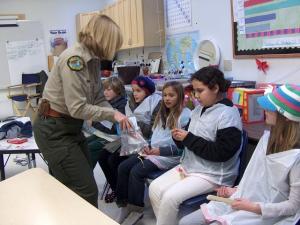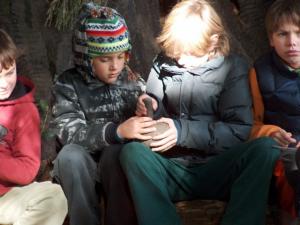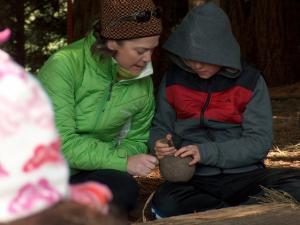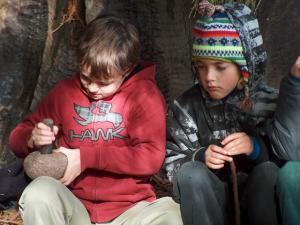 Nine-year-olds Corey Mensinger and Ronan Lee each picked up the end of a short redwood log and carried it a few feet to where their classmates were arranging other logs and wood pieces into a large circle on the ground underneath the redwood canopy. The students were setting up a ‘gathering place’ where they could sit together, hear stories from Ohlone folklore, and learn about the culture of Native Americans who once occupied the region, as well as the Spanish soldiers and padres who came later to claim territory and convert them to Christianity.
Nine-year-olds Corey Mensinger and Ronan Lee each picked up the end of a short redwood log and carried it a few feet to where their classmates were arranging other logs and wood pieces into a large circle on the ground underneath the redwood canopy. The students were setting up a ‘gathering place’ where they could sit together, hear stories from Ohlone folklore, and learn about the culture of Native Americans who once occupied the region, as well as the Spanish soldiers and padres who came later to claim territory and convert them to Christianity.
 “I wanted my students to gain some insight and hands-on experience on what it might have been like to live the traditional Ohlone lifestyle,” explains Linda Pope, these students’ teacher, “and to understand how Spanish mission life changed the lives of the Ohlone people.”
“I wanted my students to gain some insight and hands-on experience on what it might have been like to live the traditional Ohlone lifestyle,” explains Linda Pope, these students’ teacher, “and to understand how Spanish mission life changed the lives of the Ohlone people.”
 The boys and their fourth grade class from Mount Madonna School were participating in a ‘simulated field trip’ on the school campus. A field trip was previously scheduled to nearby Chitactac-Adams County Heritage Park in Gilroy, the site of a former Ohlone village; however concerns over extremely cold winter weather prompted a change in locale – but not the lesson.
The boys and their fourth grade class from Mount Madonna School were participating in a ‘simulated field trip’ on the school campus. A field trip was previously scheduled to nearby Chitactac-Adams County Heritage Park in Gilroy, the site of a former Ohlone village; however concerns over extremely cold winter weather prompted a change in locale – but not the lesson.
In preparation, Santa Clara County Parks Interpreter (and MMS parent) Lynda Will gathered acorns, stone mortar and pestle, elderberry ‘stick dice’ and other Ohlone ‘artifacts’; as well as the stories she uses as teaching aides, and brought these with her to share with the MMS students. During the day Will led students through an array of hands-on activities designed to give them a sense of an Ohlone villager’s daily life.

 “My goal is to teach them by engaging as many of their senses as possible,” Will explains. “By looking, listening, touching and doing, people absorb and remember more. I feel the best way to do this is to immerse them in the Ohlone traditional ways during the morning and then strip it all away before discussing the Mission Period.”
“My goal is to teach them by engaging as many of their senses as possible,” Will explains. “By looking, listening, touching and doing, people absorb and remember more. I feel the best way to do this is to immerse them in the Ohlone traditional ways during the morning and then strip it all away before discussing the Mission Period.”
“Kan-rakaat Lynda,” Will told the students, using the Mutsun language spoken by the Ohlones of the area. “This means ‘my name is Lynda.’
“Hinkay men raakat?” she said next. “This means ‘What is your name?’” Turning to the classmate next to them, students practiced the phrases – and seemed to have fun speaking the unfamiliar sounds.




 Students learned about some of the many natural resources utilized by the Ohlone for their daily lives, including various nuts and plants, like grasses and tule woven into mats, boats, and duck decoys; feathers, handmade cooking utensils, some made from rocks; and tools, spears, and musical instruments made from deer antler and bones.
Students learned about some of the many natural resources utilized by the Ohlone for their daily lives, including various nuts and plants, like grasses and tule woven into mats, boats, and duck decoys; feathers, handmade cooking utensils, some made from rocks; and tools, spears, and musical instruments made from deer antler and bones.
“Everything the Ohlone did came from the land,” Will tells the students. “They wove baskets into large acorn granaries to store the acorns they gathered. These baskets weren’t bug proof. What do you suppose they put in there to deter the bugs?”
“Some kind of stinky plant?” answers fourth grader Aria Huth.
“That’s right,” Will replies. “A strong-smelling plant. They used bay leaf, because bugs don’t like it.
“Kids always seem to engage more, understand more, and get excited by hands-on activities that teach concepts through kinesthetic-sensory activities,” notes Will later. “The students were truly having a good time. And when I asked questions later during the PowerPoint presentation, students were able to give meaningful answers showing they connected to the Ohlone and understood their plight.”
While outdoors students engaged in a traditional Ohlone activity, hoop and spear, a spear-throwing game of skill that helped Ohlone boys improve their accuracy with targets, in preparation for the hunting they would do as adults – although Ohlone boys and adult males also played it for recreation.
Later in the classroom, students split into pairs and played the stave game, tossing a handful of lightweight elderberry ‘stick dice’ onto the floor in a game of chance.
“This is actually fun,” commented fourth grader Savannah Cambell. Cambell took turns with the ‘dice’ with friends Violet Forbes and Kira Kaplan. All three girls quickly got the hang of the scoring system and kept track as they played.
Then, a few students at a time were invited them over to another area of the classroom where they were given new clothing (a trash bag), and some colorful beads.
This activity was part of a simulation designed to help students experience what it might have been like for Native Americans entering into mission life. The students were spoken to and allowed to reply only in Pig Latin, not their native language. They were given beads and candy for assimilating; while beads were taken away or “time outs” given for using their old language or refusing to cooperate.
Afterwards students discussed what it might be like to have all that was normal taken away, and to be forced into a new life and routine.
Cast as an Ohlone being shepherded toward mission life, Mensinger said he didn’t like the forced changes. “It was hard to learn Pig Latin,” he says, “but I got used to it.” Classmate Jenna Watts agrees: “Some of us caught on to the language. I liked when we had do all the new activities.”
“It was fun but also hard and weird,” adds fourth grader Claire Chandler, “because we didn’t know what was going on or what to do.”
Will told students that the Ohlone would have been punished severely with whippings when they resisted assimilation and rewarded with better jobs and status in the Missions when they conformed. The students began to understand why the Ohlone had assimilated almost completely and left their traditional ways behind.
“Before the Spanish arrived, there were about 10,000 Ohlone people living south of present-day San Francisco and around the Monterey Bay area,” Will shared with the class. “During the heyday of the Spanish mission system, it’s estimated that 60% of the Ohlones living in this system died from disease, with another 20% dying from malnutrition or violence. By the time the Spanish missions declined, only about 2,000 Ohlones remained.
“Learning the truth of how the Ohlone assimilated into the Missions and the price to their culture is not an easy truth,” says Will. “Yet, it is an important one. In a world where empathy seems to be lacking in many places, one goal for this program is to teach the kids empathy for others, especially those who are disadvantaged and can’t speak for themselves. By role playing, my hope is that when faced with real life decisions the children will remember this lesson with every sense of their being, and choose to honor diversity rather than force conformity. In my job, I have the children for only a moment, but I hope it’s enough to light a spark that they’ll carry with them and use to kindle more life lessons.”
#####
Contact: Leigh Ann Clifton, Media & Public Relations,
Nestled among the redwoods on 355 mountaintop acres, Mount Madonna is a safe and nurturing college-preparatory school that supports students in becoming caring, self-aware and articulate critical thinkers, who are prepared to meet challenges with perseverance, creativity and integrity. The CAIS and WASC accredited program emphasizes academic excellence, creative self-expression and positive character development. Located on Summit Road between Gilroy and Watsonville.
